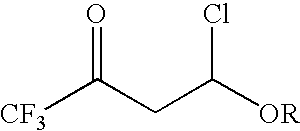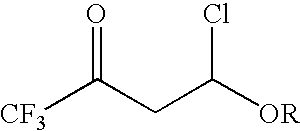4-chloro-4-alkoxy-1,1,1-trifluoro-2-butanones, their preparation and their use in preparing 4-alkoxy-1,1,1-trifluoro-3-buten-2-ones
a technology of trifluoro-2-butenone and 4-alkoxy, which is applied in the preparation of carbonyl compounds, organic chemistry, chemistry apparatus and processes, etc., can solve the problems of relatively high cost and unstable stability of 4-alkoxy-1,1,1-trifluoro-3-buten-2-ones
- Summary
- Abstract
- Description
- Claims
- Application Information
AI Technical Summary
Problems solved by technology
Method used
Image
Examples
example 1
Preparation of 4-Chloro-4-ethoxy-1,1,1-trifluoro-2-butanone
[0025]To a 100 mL three neck round bottom flask fitted with a thermocouple and a dry ice / acetone condenser was charged with 26.4 g (0.37 mol) of ethyl vinyl ether. The reaction vessel was then submerged into an ice-water bath for cooling Then 49 g (0.37 mol) of trifluoroacetyl chloride was bubble sub-surface through the reaction mixture. After completing the addition of the acid chloride, the ice-water bath was removed and the solution was allowed to warm to room temperature. The internal reaction temperature was not allowed to rise above 25° C. The reaction progress could be monitored by GC. GC analysis indicated that the reaction mixture contained un-reacted starting material. The reaction mixture was cooled in an ice-water bath and another 13 g (0.09 mol) trifluoroacetyl chloride was bubbled sub-surface through the reaction mixture. GC analysis indicated that the reaction still contained starting material so the process w...
example 2
Preparation of 4-Chloro-4-ethoxy-1,1,1-trifluoro-2-butanone
[0026]To a 50 mL three neck round bottom flask fitted with a thermocouple and a dry ice / acetone condenser was charged with 20 mL of toluene followed by 3.77 g (0.052 mol) of ethyl vinyl ether. The reaction mixture was then cooled in an ice-water bath and then 8.77 g (0.066 mol) of trifluoroacetyl chloride was bubbled sub-surface through the reaction mixture. The internal temperature rose from 3° C. to 5° C. The ice-water bath was removed and the solution was allowed to warm to ambient temperature and stir for an additional hour. Once the reaction was complete, GC analysis indicated the crude reaction mixture contained 4-chloro-4-ethoxy-1,1,1-trifluoro-2-butanone as the major product.
example 3
Preparation of 4-Chloro-4-ethoxy-1,1,1-trifluoro-2-butanone
[0027]A 500 mL jacketed reactor was equipped with a cooling bath and mechanical stirring. To this vessel, blanketed with nitrogen, was charged 95.81 g (1.33 mol) of ethyl vinyl ether in one portion. The circulation bath temperature was set at 0° C., mechanical stirring was turned on, and the reactor contents were allowed to cool down. Once the internal reaction temperature reached about 2° C., then 148.1 g (1.12 mol) of trifluoroacetyl chloride was slowly bubbled through the reaction mixture via a subsurface dip tube over a 2.5 h period. The internal reaction temperature was kept below 12° C. by adjusting the rate of gas addition. Once the trifluoroacetyl chloride addition was completed, the subsurface dip tube was removed from the vessel and the reaction mixture was allowed to stir with cooling for an additional 1 h 27 min. The reaction mixture was bottom drained from the vessel to afford 232.1 g of a colorless liquid. 19F ...
PUM
| Property | Measurement | Unit |
|---|---|---|
| temperature | aaaaa | aaaaa |
| temperature | aaaaa | aaaaa |
| Temperatures | aaaaa | aaaaa |
Abstract
Description
Claims
Application Information
 Login to View More
Login to View More - R&D
- Intellectual Property
- Life Sciences
- Materials
- Tech Scout
- Unparalleled Data Quality
- Higher Quality Content
- 60% Fewer Hallucinations
Browse by: Latest US Patents, China's latest patents, Technical Efficacy Thesaurus, Application Domain, Technology Topic, Popular Technical Reports.
© 2025 PatSnap. All rights reserved.Legal|Privacy policy|Modern Slavery Act Transparency Statement|Sitemap|About US| Contact US: help@patsnap.com



